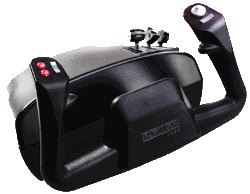|
Flight Yokes
by Ed "Lozhechnik" Reddy |
||||
|
For me, flying a bomber such as the WWII Lancaster with a joystick has never felt very authentic. Flying a large, bomb-laden multi-engine behemoth with a fighter-style joystick takes away from the immersiveness I am trying to attain. Granted, a joystick can provide the control needed, but it's just too nimble of an input device for the true bomber experience. Dedicated bomber aircraft like the Lancaster, B-17, and Ju-88 are not nimble creatures. If aircraft were animals, fighter aircraft would be thoroughbred horses and bombers would be oxen---flying, metallic oxen designed to furrow the landscape not with a plow but with tons of high-explosives. And what do farmers use to control oxen? . . . why a yoke of course! What we bomber jocks need is a flight yoke and not a joystick. Okay, so I've established the need for a yoke in flying heavy bomber aircraft sims, but yokes were also used in multi-role fighter-bomber aircraft such as the A26B Invader, P38J Lightning and the RAF's venerable Mosquito. German fighters such as the Ju88 and the Japanese G4M2 Betty also used yokes for control inputs. If you are an authenticity nut like me, you can still get a yoke and fly fighter-type aircraft (the P38 Lightning best qualifies, in my opinion). If you are a civilian aviation afficiando, then you already know all about yokes but I'm not going there. I'm going to limit my discussion to yokes for combat sims. But now the question: what yokes are available for simmers and which, if any, should we buy? Before I get too deeply into a dissertation on features, I think it would be helpful to state some obvious differences between a flight yoke and a joystick, so bear with me. Yoke vs. Joystick What is the difference? Falling back on my Sherlock Holmes fanclub training manual, I determined I could begin to answer this fiendish little conundrum by simply looking at the two types of controls. Ah ha! A PC gamer's joystick is simplicity incarnate: it's a vertical stick with a gimbled end. It can be placed in any position within its two-dimensional sphere of movement yet it only has two points of attachment: a left/right x-axis attachment (ailerons) and a forward/back y-axis attachment (elevator.) Control inputs are translated into opposite directional inputs below the pivot point (the software sorts out the rest, as does the software or cables in a real plane.) These controls are very responsive, require very little in terms of mechanical parts, and they take up very little space in order to house all their movements and functions. A PC yoke, on the other hand, does not pivot. It has a steering wheel that rotates around the left/right x-axis, and a rod that travels in a linear fashion along the forward/back y-axis. Yokes, especially PC yokes, are relatively large beasts that consume desk space like oxen in a watering hole during the hot season in Africa. |
 Control-wise, a yoke and a joystick do the same thing: both let you fly the aircraft. But a yoke has two primary advantages over a joystick within the context of heavy aircraft: first, it gives you more leverage - a necessity when trying to pull a four-engine, nineteen-ton aircraft out of even the most shallow of dives. Well, okay, even though none of the yokes in this review have force feedback, I can still "feel" those nineteen tons through my screen. Similarly, if your aircraft had half its tail blown off by an enemy fighter you and your co-pilot would be heaving with all of your combined strength on the yokes just to keep the aircraft straight and level (again, it's an immersion thing.) Second, since both of your hands are on the wheel, a yoke allows you to hold and maintain a control input position with more accuracy and less effort. Steady As She Goes! It's tough to hold a perfect 20 degree bank for any extended period of time with a fighter joystick, especially if you need to change to a side-view where there is no horizon for reference. This is because with a joystick you have nothing to off-set or lock your control input position. Invariably, with a joystick, your hand will wander as you look out that side view window with the equally invariable result of augering your aircraft into a hillside. A yoke allows you to put your aircraft into a reasonable degree of bank and lock yourself into that position indefinitely - regardless of where your view may be. And this, dear reader, are the key differences between a joystick and a yoke. First, the amount, or distance, of physical input required by the pilot to deflect the control surfaces of the aircraft. A joystick requires relatively short and subtle inputs using the wrist action of only one hand, whereas a yoke requires more exaggerated input movements using both arms and hands to achieve a similar effect. And second, the ability or inability to lock-in a control input position -joysticks don't, yokes do. The trade-offs for the extra size, physical work, and input mileage required by yokes is finer and more exact control inputs. The Main Event Now that the prelims have been completed, let's get to the main event: the "Yokes In Review." I was actually surprised that there are only three real contenders in the PC yoke arena, and each is wildly different from the others. These are the CH Flight Yoke, Suncom's G-Force, and Precision Flight Controls Cirrus Yoke. Other yokes were found but they were all cheapo no-name brands and often came packaged with cheapo no-name flight simulators. Go to CH Flight Yoke Review
|
|||
|
Copyright © 1997 - 2000 COMBATSIM.COM, INC. All Rights Reserved. Last Updated August 3rd, 1999 |
||||
